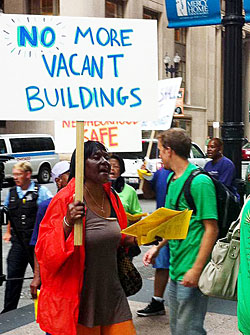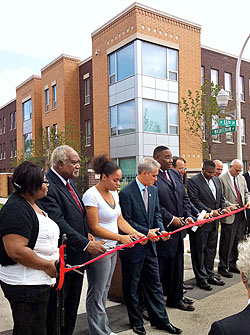
At a July 18 event on LaSalle Street, people march in support of the Keep Chicago Renting Ordinance.
Two pieces of recent news from the housing front reveal just how deep a hole the city’s supply of moderately priced rental apartments is in.
Last week the Lawyers’ Committee for Better Housing reported that nearly 17,000 Chicago apartment buildings went into foreclosure from 2009 through 2011. That adds up to 51,792 apartments.
Many of the tenants in those apartments were paid up on their rent but were kicked out by the foreclosing owners. That’s why the Chicago City Council is now set to consider the Keep Chicago Renting Ordinance, which would require lenders to allow tenants to stay in their apartments until a new owner takes the deed to a foreclosed building.
“We know that tenants are being pushed out, but we don’t know how many of them,” says Mark Swartz, legal director of the Lawyers’ Committee. “We don’t know how many of these loans were worked out or taken over in short sales.” The group’s research indicated that 11,600 of the 13,814 units foreclosed in 2011 went into bank ownership. Swartz says apartments average 3.5 residents; that would mean some 40,613 rental tenants were a risk of losing their apartments during foreclosure that year alone.
“We know there is a crisis of displacement,” Swartz adds. “These tenants often move from a bad situation to a bad situation.”
That’s in part because of the city’s extreme and long-running shortage of affordable rentals. While developers are building lots of luxury-priced apartments downtown, a report released last fall by DePaul University’s Institute for Housing Studies said that the city is short about 180,000 affordable apartments—and it isn’t plugging that hole fast enough.

Congressman Danny Davis, Mayor Rahm Emanuel, and Alderman Jason Ervin join tenants and others at the ribbon-cutting ceremony Tuesday at the Park Douglas Apartments.
Which is where the other recent housing story comes in. On Tuesday morning, Mayor Rahm Emanuel, Representative Danny Davis, Alderman Jason Ervin (28th), and others participated in a ribbon-cutting ceremony at the Park Douglas Apartments, a developer-built residential community on the former site of the Chicago Housing Authority’s Ogden Courts.
It’s an innovative project, with Sinai Health System, the private developer Brinshore, and other groups collaborating to create 137 new apartments. The long-range plan calls for a total of 300 new or restored apartments and a new hospital building in the blocks between Roosevelt Road and Ogden Avenue, largely along Washtenaw Avenue, just east of Douglas Park in Lawndale.
The full-block building at 13th Street and Washtenaw cost $44.1 million. It was built sustainably—with high levels of insulation and other green features—and handsomely, with a mix of brick colors, metal exterior panels, and brick dentil detailing at the top. “It’s beautiful on its own,” Emanuel said, “but the true story is what it replaced,” a hunk of notoriously decrepit public housing.
Steve Koch, chairman of Sinai Heath System, noted that Mount Sinai Hospital has been in the neighborhood for a century, and that the new apartment-and-hospital plan demonstrates the organization’s commitment “not only to caring for sick people but to [working for] the health of the community.”
Impressive as it is, Park Douglas points up the need for more affordable rentals in Chicago. As its developers noted, the building, though newly completed, is already full. That’s 137 apartments, all taken swiftly. Only 179,863 to go before the gap in affordable rental is filled.


